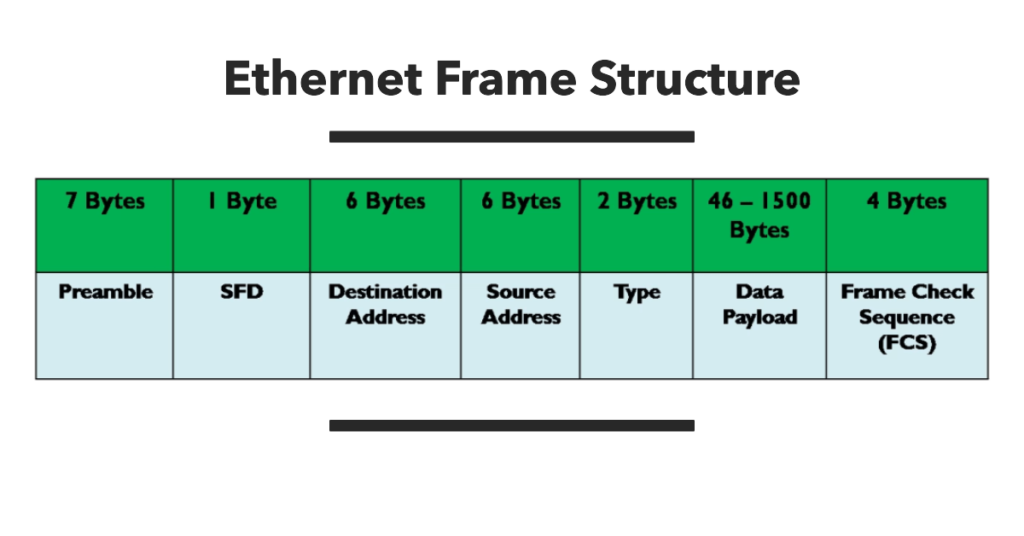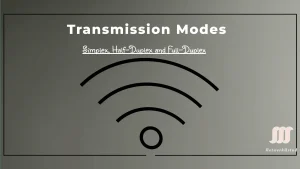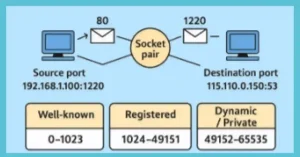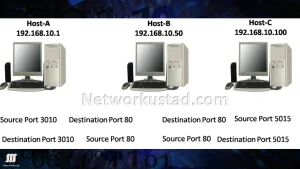In 2025, the Ethernet frame structure, defined by IEEE 802.3, is the backbone of wired and wireless networking, enabling reliable data transfer in everything from smart homes to data centers. This guide explores the components of an Ethernet frame, their roles, and their relevance in modern networks like 400GbE and IoT.
Overview of Ethernet Frame Structure
The Ethernet frame encapsulates Layer 3 Protocol Data Units (PDUs) with headers and trailers, ensuring accurate data delivery. Used in Ethernet-II format for TCP/IP networks, the frame structure remains consistent across speeds, from 10 Mbps to 400 Gbps.
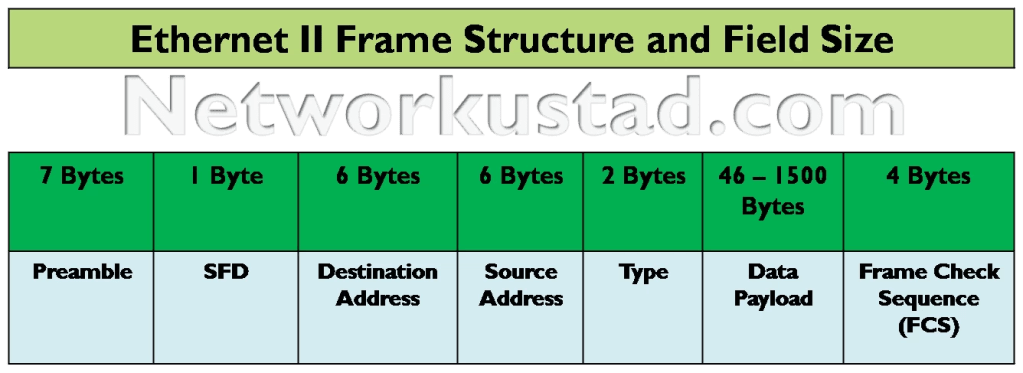
Ethernet Frame Components
It ranges from 64 to 1518 bytes (excluding the preamble), with larger jumbo frames (up to 9000 bytes) used in modern networks. Frames smaller than 64 bytes (“runt frames”) or exceeding 1500 bytes without jumbo support are discarded.
Preamble and Start Frame Delimiter (SFD)
- Preamble (7 bytes): Synchronizes sender and receiver, signaling a new frame.
- SFD (1 byte): Marks the frame’s start, ensuring precise timing.
- Role: Prepares devices for frame reception, critical in high-speed networks like 400GbE.
Destination MAC Address
- Size: 6 bytes.
- Function: Identifies the recipient’s MAC address (unicast, multicast, or broadcast).
- Process: Devices compare the frame’s address with their MAC address, accepting matches.
Source MAC Address
- Size: 6 bytes.
- Function: Identifies the sender’s MAC address (always unicast).
- Use: Ensures the recipient knows the frame’s origin.
EtherType
- Size: 2 bytes.
- Function: Specifies the encapsulated protocol (e.g., 0x800 for IPv4, 0x86DD for IPv6, 0x806 for ARP).
- Example: In IoT networks, EtherType identifies lightweight protocols for smart devices.
Data (Payload)
- Size: 46–1500 bytes (padded if smaller to meet 64-byte minimum).
- Function: Carries the Layer 3 PDU (e.g., IP packet).
- Note: Jumbo frames (up to 9000 bytes) are common in data centers for high throughput.
Frame Check Sequence (FCS)
- Size: 4 bytes.
- Function: Detects errors using a CRC algorithm.
- Process: The sender calculates the CRC; the receiver verifies it. Mismatches result in frame rejection.
| Field | Size | Function | Example Use Case |
|---|---|---|---|
| Preamble | 7 bytes | Synchronization | 400GbE timing |
| SFD | 1 byte | Marks frame start | Wi-Fi 7 frame detection |
| Destination MAC | 6 bytes | Identifies recipient | IoT device addressing |
| Source MAC | 6 bytes | Identifies sender | Switch-to-server link |
| EtherType | 2 bytes | Specifies protocol | IPv6 in smart homes |
| Data (Payload) | 46–1500 bytes | Carries higher-layer data | Data center jumbo frames |
| FCS | 4 bytes | Error detection | Ensuring data integrity |
VLAN Tagging (IEEE 802.1Q)
- Size: Adds 4 bytes (Tag Protocol Identifier + Tag Control Information).
- Function: Enables virtual LANs for network segmentation.
- Use: Common in enterprise networks for traffic prioritization and security.
Ethernet Frames in 2025
Ethernet frames remain critical in:
Wi-Fi 7: Adapts frame structure for high-throughput wireless.
400GbE: Supports AI and hyperscale data centers with jumbo frames.
IoT: Enables efficient addressing in dense networks.
5G Backhaul: Ensures low-latency frame delivery.
FAQs
What is the purpose of an Ethernet frame?
An Ethernet frame encapsulates Layer 3 data with headers and trailers, ensuring reliable delivery across networks.
What are the key components of an Ethernet frame?
Key components include Preamble, Start Frame Delimiter (SFD), Destination and Source MAC addresses, EtherType, Data (46–1500 bytes), and Frame Check Sequence (FCS).
How does the FCS ensure data integrity?
The FCS uses a CRC algorithm to detect errors; mismatches between sender and receiver calculations result in frame rejection.
What is VLAN tagging in Ethernet frames?
VLAN tagging (IEEE 802.1Q) adds a 4-byte tag to frames for network segmentation and traffic prioritization.
How are Ethernet frames used in modern networks?
Ethernet frames support 400GbE, IoT, 5G backhaul, and Wi-Fi 7, enabling high-speed, reliable data transfer.

